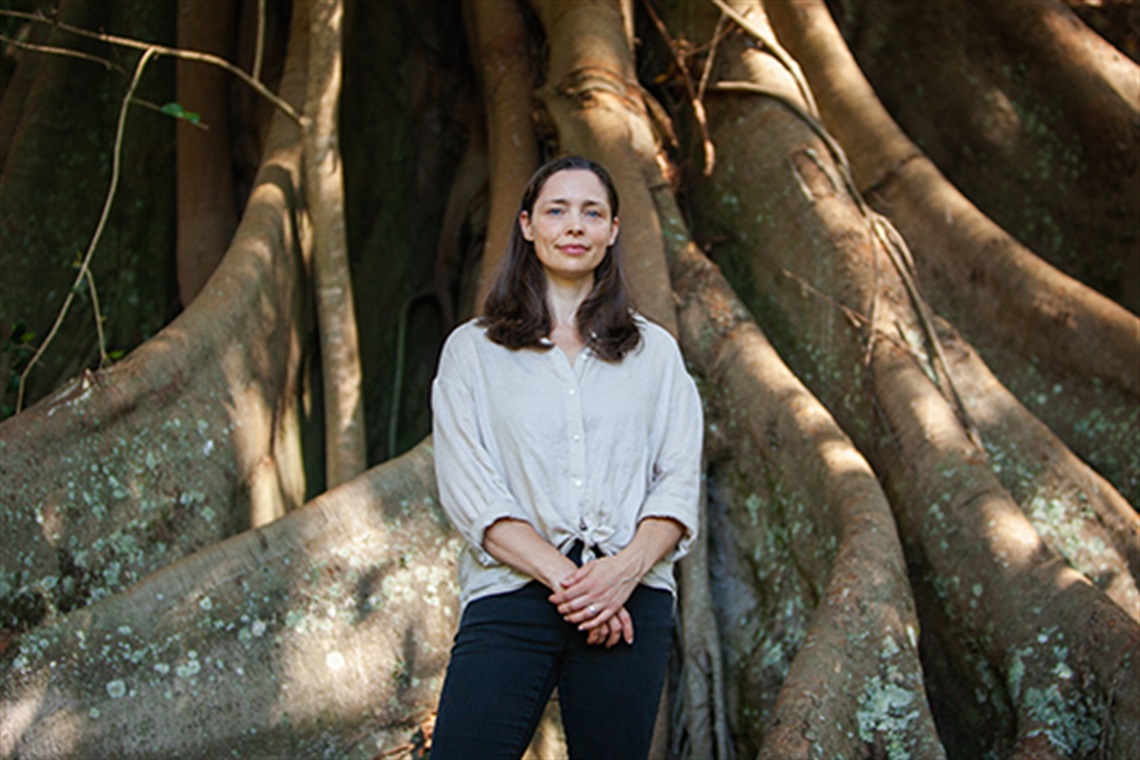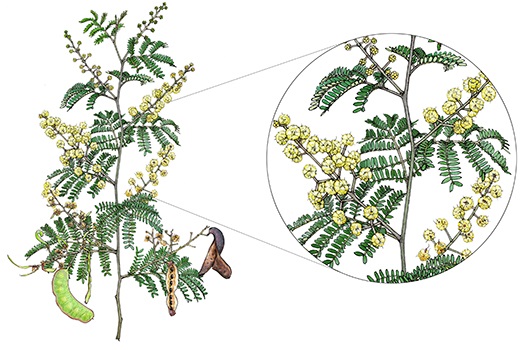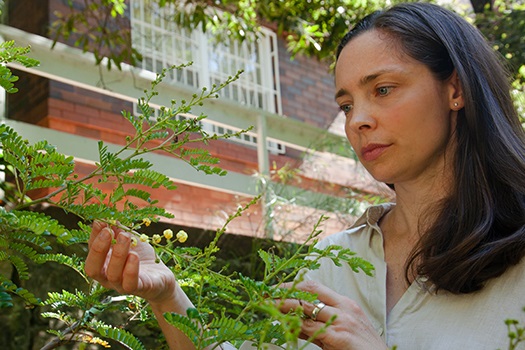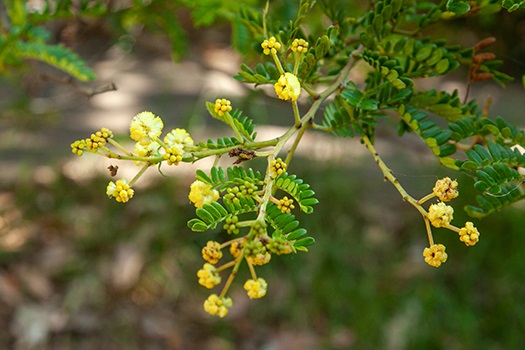Q + A with local Bushcare volunteer Jo Bridge
Published on 02 February 2022

Local Bushcare volunteer, botanical artist and mother-of-two Josephine Bridge has admired our local bushland for many years. Her artwork depicting a local threatened species forms part of important new signage at Gap Park, Cooper Park and Parsley Bay. The signs were funded with a NSW Government Saving Our Species grant to help protect this rare plant in our area.
Tell us about yourself?
I grew up in Paddington - and have such fond memories of playing in all the precious pockets of bushland in Woollahra Council. We also spent a lot of time up at Dangar Island, where my family has a property overlooking the Hawkesbury River. I’ve always felt an affinity with both of these places - and now understand that they are in fact closely linked - they’re both part of the Hawkesbury Sandstone geological layer of Sydney - and share a similar landscape, soil, and community of plants. My professional background is actually in architecture but I recently made the decision to focus full-time on my lifelong passions, fine art and illustration.
How did you become involved with Bushcare? How long have you been a volunteer?
Bushcare - in an informal sense - was ever-present for me as a kid. When my parents bought the block up at Dangar it was covered in invasive weeds, which they worked so hard to remove over the years. And almost magically - once the weeds were gone - the bush sprang back to life all by itself. My husband and I moved to our home near Cooper Park nine years ago, and I was (and still am) mesmerised by this little natural jewel in the heart of a dense suburban area. One day I came across a Bushcare Woollahra sign with contact details for the group and I started attending sessions on Saturdays. I’ve found Bushcare attracts a really interesting, dedicated group of people and the conversations are fascinating.
What do you love about Bushcare?
One of the main things I love is just being immersed in nature for hours at a time. We don’t often get the opportunity to just sit still in the bush. To be surrounded by all the smells, the sounds, you really start to notice the behaviour of animals, from birds down to the tiniest insect. And there’s something strangely satisfying about weeding - it’s deeply human I think to get your hands dirty and be that close to the earth. When you spend hours in a small area you become really focussed on detail - recognising the plants by slight variations in leaves and texture, seeing what’s flowering, what’s bearing fruit. It’s also amazing once you start learning how many fruits and leaves are actually edible - it adds a whole new sensory dimension to the bush. Of course, the sense of community is a really important aspect of Bushcare.
What drives your interest in botanical drawing? How did you start?
My mum was the first one to explain to me the beauty of a botanical drawing. Unlike a photo, which is only able to capture a snapshot of a plant at a specific stage - with a botanical drawing you are able to illustrate every stage of a species’ cycle, from bud to flower to mature fruit. Perhaps it’s my background in architecture, but I’m very drawn to the diagrammatic nature of this type of illustration. Botanical drawing is a little like Bushcare - in that in that it requires you to be patient, to spend a lot of time with your subject, looking closely, learning and understanding. Through my illustrations I hope to communicate what I have learnt about these species in a way that is accessible to everyone. I’d like to help people - even those who aren’t trained in botany - to learn how to identify plants, to recognise those aspects which make a species unique, and ultimately (I hope) fall in love with the Australian bush and want to protect it.

Sunshine Wattle (Acacia terminalis subsp. Eastern Sydney) by Josephine Bridge, featured on signage at Gap Park, Cooper Park and Parsley Bay.
Do you have any favourite species to draw?
The very first species I drew was Platylobium formosum - the Handsome Flat Pea - and through that process I discovered my love of illustration, so it will always hold a special place in my heart. Since then I’ve been selecting species which are quite different to one another; it’s the contrast and diversity between them all which I find most fascinating. I’d like to try to illustrate all the species of the Hawkesbury Sandstone (an ambitious project for a single lifetime).
What did you think when you found out Council wanted to feature your Sunshine Wattle (Acacia terminalis subsp. Eastern Sydney) drawing on signs Gap Park, Cooper Park and Parsley Bay?
I felt very honoured to be approached by Council for this project. These parks have always been an important part of my life, and I felt privileged to be able to help raise awareness of this special subspecies which (thanks to the work of the Council team and Bushcare volunteers) is really making a comeback in these reserves.

Jo Bridge with Sunshine Wattle at Cooper Park, Woollahra
Can you tell us a bit about the Sunshine Wattle?
Acacia terminalis - commonly known as Sunshine Wattle - is an attractive shrub endemic to the east coast of Australia, with a native range from NSW to Tasmania. There are four main Sunshine Wattle subspecies; the one depicted in our illustration is Acacia terminalis subsp. Eastern Sydney. It can be recognised by its classic ‘bipinnate’ leaf structure, which is typical of many Acacias. This particular subspecies is very rare, listed as Endangered in NSW, and only found on a select few sites in Sydney’s eastern suburbs. But thanks to concerted regeneration efforts by a number of organisations, including Woollahra Council, its populations are now beginning to stabilise.
Any other passions you’d like to share?
My family is my main passion - and living where we do, many of our family adventures are centred around Cooper Park. Kicking a soccer ball, ‘bushwalking,’ playing hide-and-seek, making little art projects with the girls. I love walking past the Bushcare sites with my eldest (who’s 3), teaching her about the different species. One of my proudest moments was when she ran up to me bursting with excitement a few months ago saying, ‘Mummy mummy! The Dianella flowers have turned into berries!’ Otherwise, I have too many passions for the spare time available! I enjoy dancing flamenco and writing poetry and I’ve always been passionate about art and design. My preferred medium is graphite - I work on commissions as well as fine art pieces. I’m also passionate about sculpture, woodwork and land-art. I’m very excited about engaging full-time in my art-making practice over the coming months and seeing what emerges. If you’re interested, I will be posting my progress to my Instagram pages: @josephine_bridge, @josephine_bridge_art, and @hawkesbury_sandstone_flora.
Why do you feel it’s important to protect threatened species?
Protecting threatened species is a vital part of a larger project - protecting our natural ecosystems in all their fullness and biodiversity. So much of the bushland which once covered Sydney (and the whole east coast of Australia) is now gone, and I feel we must do all we can to protect what remains. Our local area supports a huge range of plants, fungi, and animals - they’ve co-evolved over millions of years and are linked through exquisitely complex interrelationships.

Sunshine Wattle (Acacia terminalis subsp. Eastern Sydney)
What can people do to help protect threatened species?
There are a few things you can do to help and have fun along the way:
- Get out and enjoy the bush! Fostering a love and appreciation of our bushland is the most important step I think! When we love something, we are more likely to care for, and respect it. Go bushwalking, visit your local reserves, go on a local bush tucker guided tour. Take note of the time of year when particular flowers come out, and watch as they turn into fruit.
- Stick to the path - When you’re walking in the park, it’s important to stick to the tracks so you don’t inadvertently trample little baby plants.
- Join a Bushcare group - It really is such a rewarding experience, and there are so many different opportunities in the Woollahra Council area. You could also volunteer at the Council’s nursery at Trumper Park, where you can help pot-up little seedlings.
- Plant a couple of indigenous species in your garden - There’s a preconception I think that many native species are ‘prickly’ and ‘spindly’, but there are so many species which are highly attractive (with smooth leaves, deep green foliage, and can even be cloud pruned!) The big benefit - they’ve evolved for this climate and so don’t need any additional water, fertiliser, and often do well in low light. By doing this you can help create ‘stepping stones’ for insects like native bees to venture out of local reserves and into the heart of the city.
- Learn to identify species endemic to your area - Check out great resources online and on social media if you’d like to find out more.
Thank you Jo!
If you are interested in joining one of our eight bushcare groups find out more.